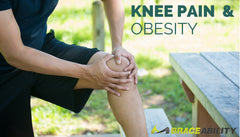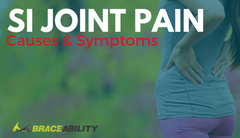The 4 Scariest Musculoskeletal Injuries Your Overweight Child Could Develop
Childhood obesity has more than DOUBLED in the past 30 years. It was estimated that in the year 2012, more than one-third of children and adolescents were either overweight or obese. As you can see, childhood obesity has become a major problem in our world today and needs to be seriously addressed. Many negative side effects accompany childhood obesity, some immediate while others are long term. For example, immediate health issues for obese children include a higher risk for cardiovascular disease, pre-diabetes, and bone and joint problems. Long-term effects include a higher risk of becoming obese adults, increased risk for certain forms of cancer, and osteoarthritis.

Immediate Risks: Cardiovascular disease, high cholesterol, high blood pressure, prediabetes, bone and joint problems, and sleep apnea social and psychological problems.
Long-Term Risks: Obesity as an adult, heart disease, type 2 diabetes, stroke, osteoarthritis, breast cancer, colon cancer, prostate cancer, and Hodgkin's lymphoma.
At BraceAbility, we specialize in providing braces, supports, and supplies for orthopedic conditions. Because of this, we believe it’s important for us to inform people on the orthopedic conditions that someone who is suffering from childhood obesity may experience.
Is My Child Obese or Overweight?
Overweight and obese are terms that explain weight ranges exceeding what is generally considered healthy. These weight ranges are usually identified by a child’s BMI or body mass index. The body mass index is calculated by taking into consideration a child’s weight, height, age, and sex. Children and adolescents with a BMI between, at, or above, the 85th percentile, and lower than the 95th percentile are considered overweight. Children and adolescents above the 95th percentile are considered obese.
To calculate your child's BMI, use this calculator created by the center for disease control to calculate your child's BMI. If you’re an adult who is wondering what your BMI is, check out our BraceAbility men's and women's BMI calculator here
The causes of childhood obesity are complex and vary case by case. It is always assumed that a poor diet and low activity levels are solely the cause of obesity. However, there is much more that have the potential to go into it. Often times it’s a combination of these things along with genetics and the environment in which the child lives. If a child has an obese biological parent the chances they will become obese are greatly increased.
Childhood Obesity and Its Effect on the Skeletal System
Childhood obesity can have severe effects on a person's musculoskeletal system. You may be wondering... What even is my musculoskeletal system? Essentially it’s the support and movement of the body created by the bones of the skeleton, muscles, cartilage, tendons, ligaments, joints, and connective tissues. A human musculoskeletal system is strong and intricately made. However, it is no stranger to health problems and injury. The likelihood of these health problems or injury increase with excess weight. Hence why it’s more common to run into orthopedic conditions in obese children.
Too much weight can greatly impact the health of a child’s bones, joints, muscles i.e musculoskeletal system. As a child gets older their bones grow in size and strength. This growth is controlled by what we call growth plates. Growth plates are the area of growing tissue near the end of the long bones in children and adolescents. Long bones each have at least two growth plates, one on each end. These are what determine the future shape of the bone as the child reaches full maturity. When a child is carrying excess weight like anything the growth plates can become damaged. With damaged growth plates children are looking at the potential for bone deformities, fractures, early onset arthritis (you can read more about back & spine arthritis here), and potentially more.
The 4 MOST Common Musculoskeletal Conditions to Affect Obese Kids:
- Flat Feet
- Slipped Capital Femoral Epiphysis
- Blount’s Disease
- Bone Fractures
Read more about these common yet dangerous bone and muscle disorders below.
Flat Feet:
In a normal foot arch, there is an upward curve in the middle of the foot. It’s the tendons and ligaments in the lower leg that form this arch and stabilize it. Although we often don’t think about the importance of our feet, they are a huge support for our entire body. Because of this, having a strong arch is important to your body’s health. If someone suffers from flat feet they have a collapsed arch. This means that the sole of their foot comes close to touching the ground. This can create an array of problems throughout your entire skeletal structure and put your joints out of alignment.
Unfortunately, flat feet is a very common problem among obese and overweight children.
Slipped Capital Femoral Epiphysis:
Kids and teens who are in the process of growing have a growth plate at the top of the thighbone. This growth plate is called the physis and is made of cartilage. The physis connects the femoral head to the thigh bone while the bone grows. With a person who is suffering from slipped capital femoral epiphysis, or SCFE, the femoral head of the thigh bone slips through the physis. This can happen for different reasons, sometimes suddenly from contact injury, or it can be gradual. SCFE is more likely to happen with kids who suffer from obesity. This is due to the extra weight that is put on the growth plate causing the slip to occur.
Blount’s Disease:
Blount disease is considered a growth disorder of the shin bone (tibia) in which the lower leg turns inward, making it look bowleg. The exact cause of Blount's disease is unknown. However, it is commonly thought that obese or overweight children are much more likely to develop Blount's disease. For the same reason as many orthopedic conditions, the excess weight placed on the growth plate causes the inward turn.
Bone Fractures:
It is very common for children who are overweight or obese to be at higher risk for broken bones, commonly referred to as fractures. This is due to the excess stress an overweight or obese child would be placed on their bones. The excess weight held is what's placing this stress on the body. The bones are also more likely to be weakened because of inactivity. Higher levels of sedentary behaviors align with overweight children who are more likely to have a fractured or broken bone.




